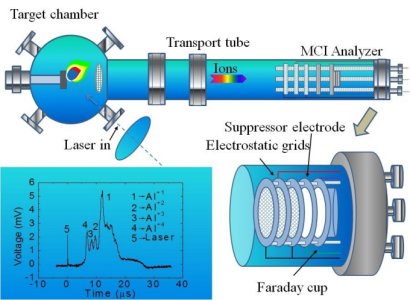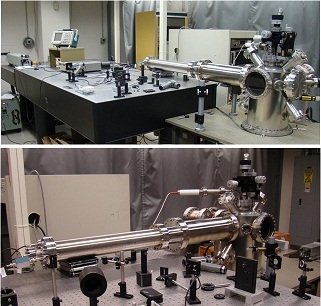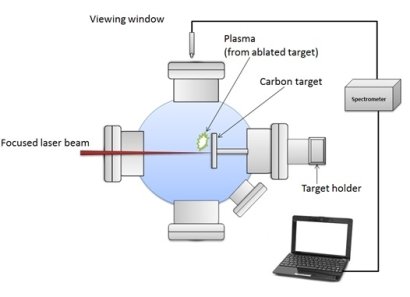The goal of this project is the development of a spark-assisted laser multicharged ion (MCI) deposition and implantation system capable of generating highly charged ions with ion charge and energy selectivity and multi-elemental capability. The energy deposited in the laser produced plasma, from a target material, is to be significantly amplified by coupling the laser plasma with spark discharge.
There are three basic methods for producing multi-charged ions include the Electron Beam Ion Trap (EBIT), Ion accelerators and laser generations.
- EBIT: Electron gun with high current density is used to trap MCI
- Ions accelerators: Uses EM fields to move particles at high speeds in defined beams which are directed towards a target creating collision induced ionization.
- Laser generation: Laser ablation of a target and optimization of plasma using a spark discharge.
This new technology is expected to enhance the production of highly charged ions from laser plasma, provide a cost-effective add-on to existing pulsed laser deposition systems, generate pulsed source of MCI, and potentially reduce equipment cost and size compared to presently available electron cyclotron resonance and electron beam ion sources.
MCI technology has applications in areas beyond micro/nano-electronics. These include highly sensitive secondary ion mass spectrometry for chemical analysis and applications in biomedicine ranging from generation of monoenergetic x-rays for diagnostic imaging to highly charged carbon ions for cancer therapy.
For example, the ability to independently change the potential energy and kinetic energy of C+N enables highly localized deposition of energy. The medical application of C+N extends to the treatment of brain tumors; this is because an ion beam could be deposited on the tumor with minimal damage to the tissues surrounding the tumor.
The development of the laser multicharged ion (LMCI) deposition and implantation system will enable new applications and research activities that depend on the MCI charge and kinetic energy selected. This process involves laser ablation of a target thereby forming high temperature and high electron density plasma where the ablated sample is vaporized and partially ionized. The ability to select ions from a large spread of kinetic energy and with different charge states gives the LMCI source wide applications in the areas of nanotechnology, microelectronics, and semiconductor processing.
The proposed spark-assisted laser multicharged ion (SALMCI) source is expected to result in obtaining a significantly higher charge state out of practically any solid target than is possible with present LMCI sources driven with a high-repetition rate (1.5 kHz) femtosecond Ti : sapphire laser. The spark-assisted LMCI source also offers a significant cost reduction and simplified design compared to MCI sources based on electron cyclotron resonance ion sources (ECRIS) and electron beam ion sources (EBIS). The main idea of the proposed design is to significantly amplify the energy contained in the laser-produced plasma by coupling the laser-produced plasma with a spark discharge. Therefore, while a laser energy pulse of ~1 mJ is used in the LMCI production, the energy deposited by the spark discharge can be ~1 J or more, resulting in three-orders-of-magnitude increase in energy deposition. Also, by proper pulsed power circuit design, the spark discharge can be used to deposit this energy in tens of nanoseconds, resulting in significant enhancement of MCI production. The idea of coupling a spark discharge with laser plasma was previously demonstrated by the PI for application in laser-induced breakdown spectroscopy (LIBS). The enhancement of LMCI production by the spark discharge also can be used for MCI production from gases, such as noble gases, since the focused femto-second laser can cause dielectric breakdown in the gases. The proposed LMCI also avoids the use of an ion acceleration stage since the ions generated from the laser plasma are accelerated by the quasi-electrostatic field in the plasma sheath, producing a relatively well-collimated ion beam perpendicular to the target surface, which for a modest laser energy of 0.5 mJ for 100 fs Ti : sapphire laser can result in ion energies that depend on ion charge and extends up to ~300 keV for Si10+. Moreover, the pulsed nature of the produced MCI facilitates charge state measurement by time-of-flight technique and selection by gate deflection plates. In addition, the pulsed nature of the LMCI source is ideal for time-resolved studies of ion surface interactions and opens many possibilities to probe the mechanism of MCI-surface interaction through probing the temporal development of secondary electron emission and photo-luminescence. Generation of highly charged ions with well-identified kinetic and potential energies will enable new research possibilities.
Work is conducted to develop a spark-assisted laser multicharged ion (SA-LMCI) deposition and implantation system capable of generating highly charged ions with ion charge and energy selectivity. In the system under construction, the energy deposited in the laser-produced plasma, from a target material is significantly amplified by coupling the laser plasma with a spark discharge.
A vacuum chamber for the MCI source was assembled and pumped down to ultrahigh vacuum. This chamber is used for the MCI source for semiconductor and metal MCI for deposition and implantation. An electrostatic time-of-flight energy analyzer based on a three grids was designed and constructed. The ions are detected by a Faraday cup with a suppressor ring to suppress the effect of secondary electron emission on the ion signal. The MCI target chamber and the electrostatic time-of-flight target chamber were used to detect laser generated MCI from an aluminum target. A schematic of the energy analyzer is shown in Fig. 1. The Faraday cup was biased negative while the target was grounded in order to detect positive ion current. The MCI setup is shown in Fig. 2. Multicharged ions are generated by a Q-switched Nd:YAG laser.
In another system, for laser ablation, we used a Q-switched Nd-YAG laser that is operated at the fundamental wavelength of 1064 nm and had a pulse width of about 40ns with a pulse repetition rate of 50Hz. The high power density at the localized point of impact causes a small part of the sample to vaporize and subsequently form high temperature plasma. Electrons gain energy from the laser pulse by a process mainly involving inverse bremsstrahlung. The energetic electrons undergo collisional excitation and ionization of the vaporized plume creating dense plasma which contains C+N. The ions and neutrons are electronically exited. Radioactive decay from this ionic and neutral exited state are detected by an optical spectrometer and used to identify the species in the plasma.
This experiment produces MCI using a laser and the spectra are observed by using an optical spectrometer. The design schematic in Fig.3 shows a detailed description of the approach. Components of this experiment include the vacuum chamber, rotating target holder, carbon target, roughing pump and a spectrometer.





